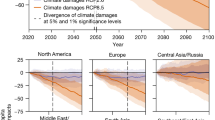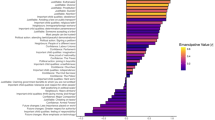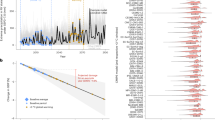Abstract
Most national and international agencies producing population projections avoid addressing explicitly the issue of uncertainty. Typically, they provide either a single projection or a set of low, medium and high variants1,2, and only very rarely do they give these projections a probabilistic interpretation. Probabilistic population projections have been developed for specific industrialized countries, mostly the United States, and are based largely on time-series analysis3. On a global level, time-series analysis is not applicable because there is a lack of appropriate data, and for conceptual reasons such as the structural discontinuity caused by the demographic transition4,5,6. Here we report on a new probabilistic approach that makes use of expert opinion on trends in fertility, mortality and migration, and on the 90 per cent uncertainty range of those trends in different parts of the world. We have used simulation techniques to derive probability distributions of population sizes and age structures for 13 regions of the world up to the year 2100. Among other things, we find that there is a probability of two-thirds that the world's population will not double in the twenty-first century.
This is a preview of subscription content, access via your institution
Access options
Subscribe to this journal
Receive 51 print issues and online access
$199.00 per year
only $3.90 per issue
Buy this article
- Purchase on Springer Link
- Instant access to full article PDF
Prices may be subject to local taxes which are calculated during checkout


Similar content being viewed by others
References
United Nations World Population Prospects: The 1994 Revision (United Nations, New Yor, (1995)).
United Nations Long-Range World Population Projections: Two Centuries of Population Growth 1950–2150 (United Nations, New Yor, (1992)).
Lee, R. D. Stochastic demographic forecasting. Int. J. Forecast. 8, 315–327 (1992).
Nordhaus, W. Managing the Global Commons(MIT Press, Cambridge, MA, (1994)).
Alho, J. Scenarios, uncertainty, and conditional forecasts of the world population. J. R. Statist. Soc. A 160, Part 1, 71–85 (1997).
Lutz, W., Goldstein, J. R. & Prinz, C. in The Future Population of the World. What Can We Assume Today?(ed. Lutz, W.) 14–44 (Earthscan, London, (1996)).
Cleland, J. in The Future Population of the World. What Can We Assume Today?(ed. Lutz, W.) 47–72 (Earthscan, London, (1996)).
8. Westoff, C. F. in The Future Population of the World. What Can We Assume Today?(ed. Lutz, W.) 73–87 (Earthscan, London, (1996)).
Lutz, W. in The Future Population of the World. What Can We Assume Today?(ed. Lutz, W.) 253–277 (Earthscan, London, (1996)).
Keyfitz, N. in Future Demographic Trends in Europe and North America. What Can We Assume Today?(ed. Lutz, W.) 235–246 (Academic, London, (1991)).
Westoff, C. F. in Future Demographic Trends in Europe and North America. What Can We Assume Today?(ed. Lutz, W.) 227–233 (Academic, London, (1991)).
Vaupel, J. W. & Lundström, H. in The Future Population of the World. What Can We Assume Today?(ed. Lutz, W.) 278–295 (Earthscan, London, (1996)).
Manton, K. G. in Future Demographic Trends in Europe and North America. What Can We Assume Today?(ed. Lutz, W.) 97–115 (Academic, London, (1991)).
Bongaarts, J. in The Future Population of the World. What Can We Assume Today?(ed. Lutz, W.) 170–195 (Earthscan, London, (1996)).
Garenne, M. in The Future Population of the World. What Can We Assume Today?(ed. Lutz, W.) 149–169 (Earthscan, London, (1996)).
Heilig, G. K. in The Future Population of the World. What Can We Assume Today?(ed. Lutz, W.) 196–249 (Earthscan, London, (1996)).
Cohen, J. E. How Many People Can the Earth Support?(Norton, New York, (1995)).
Zlotnik, H. in The Future Population of the World. What Can We Assume Today?(ed. Lutz, W.) 299–335 (Earthscan, London, (1996)).
Keyfitz, N. Applied Mathematical Demography(John Wiley, New York, (1977)).
Rogers, A. Introduction to Multiregional Mathematical Demography(John Wiley, New York, (1975)).
Lutz, W. (ed.)The Future Population of the World. What Can We Assume Today?Revised Edition. (Earthscan, London, (1996)).
Lutz, W. Scenario Analysis in Population Projection(Working Paper WP-95-57, International Institute for Applied Systems Analysis, Laxenburg, Austria, (1995)).
Lee, R. D. Probabilistic approaches to population forecasting, in Rethinking Population Projections(eds Lutz, W. & Vaupel, J. W.) (International Institute for Applied Systems Analysis, Laxenburg, Austria) (submitted (1996)).
Lutz, W. & Scherbov, S. Sensitivity Analysis of Expert-Based Probabilisitc Population Projections in the Case of Asutria(Working Paper, International Institute for Applied Systems Analysis, Laxenburg, Austria, (1997)).
Brass, W. in Biological Aspects of Demography(ed. Brass, W.) 69–110 (Taylor and Francis, London, (1971)).
Acknowledgements
This work has been conducted at IIASA (International Institute for Applied Systems Analysis).
Author information
Authors and Affiliations
Corresponding author
Rights and permissions
About this article
Cite this article
Lutz, W., Sanderson, W. & Scherbov, S. Doubling of world population unlikely. Nature 387, 803–805 (1997). https://doi.org/10.1038/42935
Received:
Accepted:
Issue Date:
DOI: https://doi.org/10.1038/42935
This article is cited by
-
Power-oriented resistance training combined with high-intensity interval training in pre-frail and frail older people: comparison between traditional and cluster training set configurations on the force–velocity relationship, physical function and frailty
European Journal of Applied Physiology (2024)
-
Transient Cannabinoid Receptor 2 Blockade during Immunization Heightens Intensity and Breadth of Antigen-specific Antibody Responses in Young and Aged mice
Scientific Reports (2017)
-
Evaluating multi-regional population projections with Taylor’s law of mean–variance scaling and its generalisation
Journal of Population Research (2017)
-
Mapping the scientific research in organic farming: a bibliometric review
Scientometrics (2015)
-
Mapping the scientific research in organic farming: a bibliometric review
Scientometrics (2015)
Comments
By submitting a comment you agree to abide by our Terms and Community Guidelines. If you find something abusive or that does not comply with our terms or guidelines please flag it as inappropriate.



